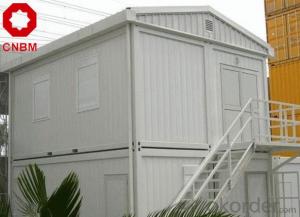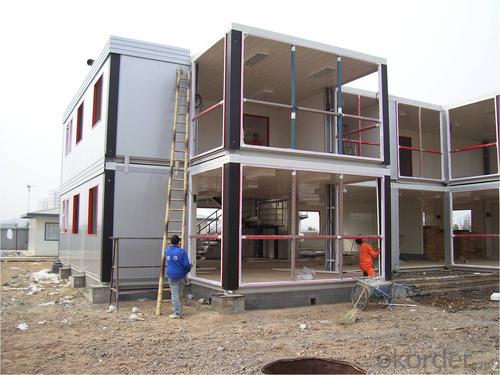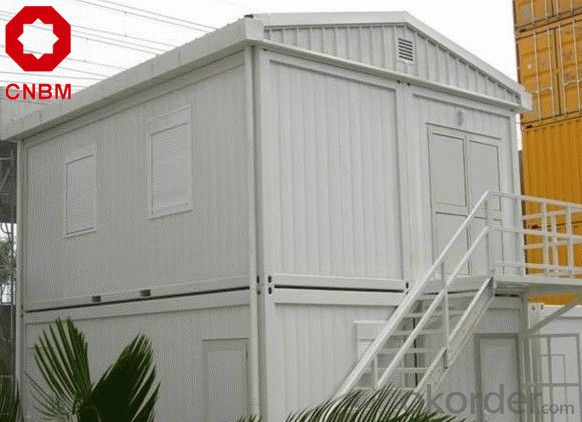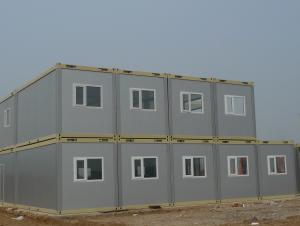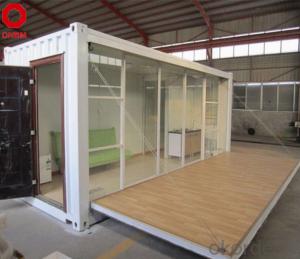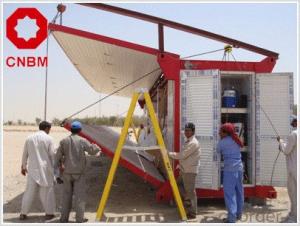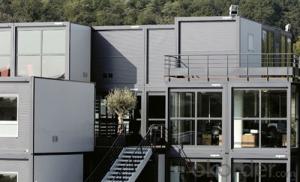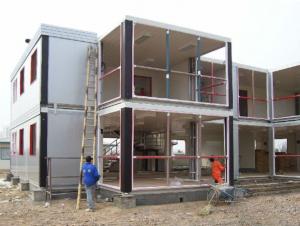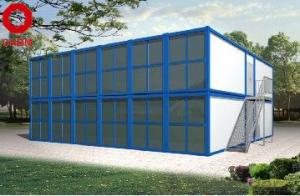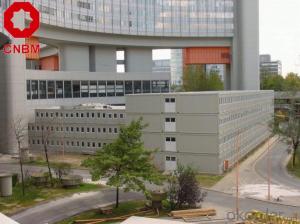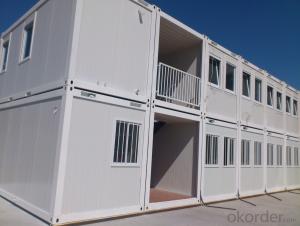Comfortable Modualr Container House/ Home Made in China
- Loading Port:
- Tianjin
- Payment Terms:
- TT OR LC
- Min Order Qty:
- 1 set
- Supply Capability:
- 1000 set/month
OKorder Service Pledge
OKorder Financial Service
You Might Also Like
Container House with Prefabricated House ;Movable Container House :
Comfortable Modualr Container House
20ft Container House,Movable House,Prefab House,Mobile House,Modular House,Low-cost Office,Toilet,ShowerSize: L * W * H = 12192 mm * 2438 mm * 2896 mm
Product features: ISO standard
Load bearing: 30480 KGS/67200 LBS
Tare weight: 3840 KGS/8465 LBS
Maximum payload: 26640 KGS 58735 LBS
2) As a storage tank
Used to store the goods, and we also offer the professional storage container
(3) Modified into a container house
Qingdao Rayfore is a professional manufacturing enterprise, specializes in container buildings
Our company is a group company,engaged in new and used shipping container sales, special containers and various container house.And the priducts are sold to all over the world.
If you have need, contact us .
| Shipping container Specification | ||||
| 20GP | 40GP | 40HQ | ||
| Length | 6058mm | 12192mm | 12192mm | |
| External Dimension(mm) | Width | 2438mm | 2438mm | 2438mm |
| Height | 2591mm | 2591mm | 2896mm | |
| Length | 5898mm | 12032mm | 12032mm | |
| Internal Dimension(mm) | Width | 2352mm | 2352mm | 2352mm |
| Height | 2385mm | 2385mm | 2690mm | |
| Door Opening | Width | 2,337~2,343mm | 2,337~2,343mm | 2,337~2,343mm |
| Height | 2,272~2,283mm | 2,272~2,283mm | 2,577~2,583mm | |
| Internal Capacity | 33.2cum | 67.7cum | 76.4cum | |
| Container Weight | 1,960~2,340kg | 3,710~3,850kg | 3,990~4,250kg | |
| Max Pay Load | 21,660~22,040kg | 26,630~26,770kg | 26,230~26,490kg | |
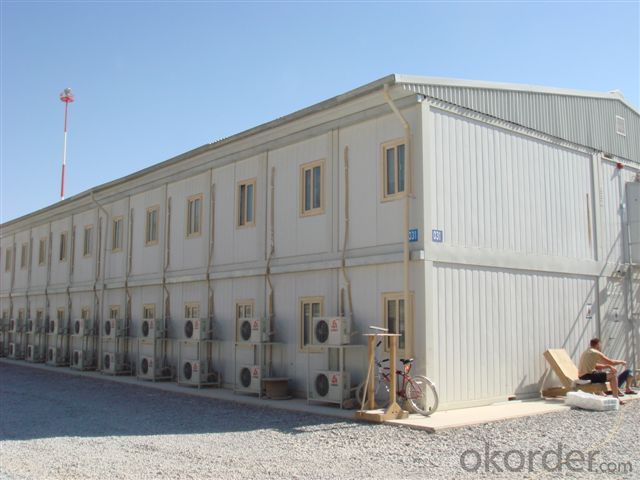
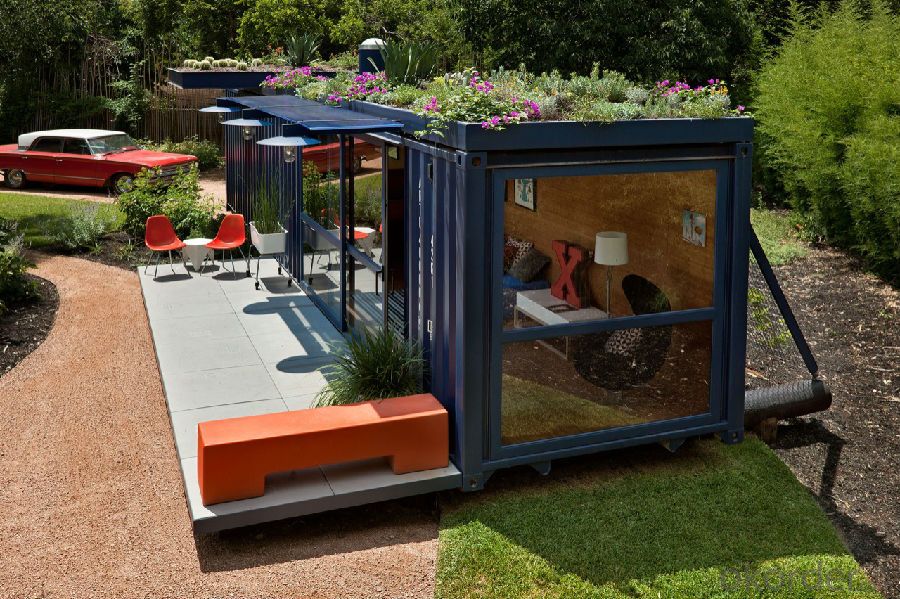
FAQ for Prefabricated Houses:
1. Q: What’s the delivery?
A: within 15-25 days after payment
2. Q: How long will your house stay for use?
A: Our light steel prefab house can be used for about 70 years.
3. Q: How long is the erection time of one house?
A: for example one set of 200sqm house, 8 workers will install it within 45 days.
4. Q: Can you do the electricity,plumbing and heater?
A:The local site works had better to be done by the customers.
- Q: Are container houses suitable for individuals with disabilities?
- Container houses can certainly be suitable for individuals with disabilities, as they offer several advantages that can accommodate their specific needs. Firstly, container houses can be designed and modified to be fully accessible, with features such as wide doorways, ramps, and accessible bathrooms that comply with disability standards. Additionally, container houses can be built on a single level, eliminating the need for stairs or elevators, making it easier for individuals with mobility impairments to navigate their living space. Furthermore, container houses can be customized to include various assistive technologies and equipment. For example, smart home technologies can be integrated into the design, allowing individuals with disabilities to control different aspects of their home environment, such as lighting, temperature, and security, through voice commands or mobile applications. These features enhance independence and convenience for individuals with disabilities, enabling them to live comfortably and safely. Container houses also offer flexibility in terms of location, making it possible to create a fully accessible living space in areas with limited housing options. They can be easily transported and installed in different locations, providing individuals with disabilities the opportunity to live in a community of their choice, closer to amenities and support networks. However, it is important to note that designing container houses for individuals with disabilities requires careful consideration and expertise. Architects, builders, and designers need to have a deep understanding of universal design principles and disability accessibility guidelines to ensure that the container house meets the specific needs of the individual. Collaboration with occupational therapists and other disability professionals is also recommended to create a truly suitable living space. In conclusion, container houses can be a suitable housing option for individuals with disabilities. With the right modifications and design considerations, container houses can offer accessibility, independence, and flexibility, enabling individuals with disabilities to live comfortably and fully participate in their communities.
- Q: What are the disadvantages of living in a container house?
- There are several disadvantages associated with living in a container house. One major drawback is the limited space available in a container. Since containers are originally designed for shipping purposes, they tend to be quite small and cramped, which can be challenging for individuals or families who require more living space. This can lead to difficulties in arranging furniture and storage, making it necessary to be creative with space utilization. Additionally, container houses may lack insulation, which can result in extreme temperatures inside the house. During hot summer months, containers can become unbearably hot, requiring additional cooling systems. On the other hand, during colder seasons, the lack of insulation can make it challenging to maintain a comfortable indoor temperature, requiring extra heating sources. Another disadvantage is the limited availability of natural light. Containers typically have small windows, which can make the space feel dark and gloomy. This lack of natural light can negatively impact mood and productivity, and may necessitate the use of artificial lighting throughout the day. Privacy can also be a concern when living in a container house. Due to their design, containers often have limited soundproofing capabilities, which means that noise from the outside or from neighboring containers can easily penetrate the living space. This lack of privacy can be a significant drawback for those who value a quiet and peaceful living environment. Furthermore, the process of obtaining permits and meeting building regulations can be more challenging when opting for a container house. Many areas have strict zoning laws and building codes that may not be easily met by container houses. This can result in a longer and more complex process to obtain necessary approvals, potentially leading to delays and higher costs. Lastly, the resale value of container houses may be lower compared to traditional houses. Container houses are still relatively new and unconventional, which can result in less demand from potential buyers. This can make it difficult to recoup the initial investment or make a profit if one decides to sell the property in the future. Overall, while container houses offer unique and eco-friendly living alternatives, they do come with a set of disadvantages such as limited space, insulation issues, lack of natural light, privacy concerns, challenges in obtaining permits, and potential lower resale value. Therefore, it is crucial to carefully consider these drawbacks before deciding to live in a container house.
- Q: Can container houses be designed with natural ventilation systems?
- Yes, container houses can be designed with natural ventilation systems. By incorporating features such as strategically placed windows, vents, and roof openings, container houses can effectively utilize natural airflow to enhance ventilation and maintain a comfortable indoor environment. This approach not only promotes energy efficiency but also allows for a healthier and more sustainable living space.
- Q: Can container houses be designed for outdoor recreational areas?
- Yes, container houses can be designed and built for outdoor recreational areas. Container houses offer versatility in design and can be customized to fit specific purposes, including outdoor recreational areas. They can be modified with various features such as outdoor decks, swimming pools, or even integrated into larger recreational complexes. Container houses are durable and weather-resistant, making them suitable for outdoor environments.
- Q: Can container houses be designed to have a home spa?
- Certainly, container houses can be designed to include a home spa. The flexibility and customization options that container houses offer allow for the incorporation of various amenities and features, including spa facilities. By carefully considering the size and layout of the container house, it is possible to create sufficient space for the spa area. This may involve combining multiple containers or extending the dimensions to accommodate the desired spa features. To support the spa facilities, it is essential to have professional installation of the plumbing and electrical systems. This includes setting up water supply and drainage systems for hot tubs, showers, and saunas, as well as appropriate wiring for lighting, heating, and other electrical spa equipment. In terms of design, container houses can be personalized to include different elements of a spa. For example, a hot tub or Jacuzzi can be seamlessly integrated into the outdoor or indoor areas of the container house. Depending on the available space and desired spa experience, saunas, steam rooms, or relaxation lounges can also be incorporated. Moreover, container houses can be designed to promote relaxation and tranquility. This can be achieved by installing large windows to maximize natural light, incorporating soundproofing for a serene environment, and using high-quality insulation to maintain optimal temperatures. Working with experienced architects and designers who specialize in container house conversions is crucial to ensure that the home spa design is not only visually appealing but also meets all safety and functionality requirements. In conclusion, container houses can undoubtedly be designed to include a home spa. With careful planning, professional installation of plumbing and electrical systems, and innovative design ideas, container houses can be transformed into luxurious and rejuvenating spaces that provide all the comforts and amenities of a spa.
- Q: Are container houses suitable for permanent living?
- Depending on various factors, container houses have the potential to be suitable for permanent living. These houses are constructed from shipping containers, which are specifically engineered to endure extreme weather conditions and can be adapted to create comfortable living spaces. Affordability is one of the primary advantages of container houses. Generally, they are more cost-effective than traditional houses, making them an appealing option for individuals seeking homeownership without breaking the bank. Furthermore, container houses can be highly personalized to meet the specific needs and preferences of the homeowner. Another significant benefit of container houses is their eco-friendliness. By repurposing shipping containers, we actively reduce waste and minimize the carbon footprint associated with conventional construction methods. Moreover, the use of recycled materials in the construction process contributes to sustainable living. However, it is crucial to consider certain factors when contemplating container houses for permanent living. Adequate insulation is essential to maintain a comfortable living environment. Effective insulation is necessary to regulate temperature and minimize heat loss, particularly in extreme weather conditions. Additionally, careful planning and installation of plumbing and electrical systems are imperative. Furthermore, it is important to note that container houses typically have limited space, which may not be ideal for large families or individuals with a substantial amount of belongings. Nonetheless, innovative design and layout can help maximize the available space and provide storage solutions. In conclusion, with the proper considerations and modifications, container houses can be a viable option for permanent living. They offer affordability, customization, and eco-friendliness. Through careful planning and adjustments, container houses can provide comfortable and sustainable living spaces.
- Q: How do container houses compare to tiny houses?
- Container houses and tiny houses have some similarities but also significant differences. Both types of housing are compact and designed to maximize space utilization. However, container houses are typically made from shipping containers and repurposed for residential use, while tiny houses are custom-built structures. Container houses often offer more durability due to their steel construction, whereas tiny houses may provide more design flexibility and aesthetic options. Additionally, container houses can be more cost-effective and easier to transport, while tiny houses allow for greater customization and personalization. Ultimately, the choice between the two depends on individual preferences, budget, and specific needs.
- Q: Can container houses be designed to have a wheelchair ramp?
- Yes, container houses can be designed to have a wheelchair ramp. The design and construction of container houses can be adapted to include a ramp that provides accessibility for individuals using wheelchairs.
- Q: Are container houses suitable for disaster relief shelters?
- Disaster relief shelters can indeed make use of container houses. Also known as shipping container homes, these structures are constructed from repurposed shipping containers that are specifically designed to endure harsh conditions and remain durable. As a result, they are highly suitable for disaster relief situations where the ability to withstand extreme circumstances and be deployed swiftly is of utmost importance. Container houses present numerous advantages as disaster relief shelters. Firstly, they are easily accessible and can be rapidly transported to affected areas. Since shipping containers are commonly employed in international trade, they can be easily obtained and repurposed for disaster relief purposes. This facilitates a prompt response to emergencies, ensuring that displaced individuals and families are provided with shelter in a timely manner. Secondly, container houses are built to be robust and capable of withstanding severe weather conditions. Constructed with sturdy materials like corten steel, they are resistant to corrosion, fire, and strong winds. Therefore, they guarantee the safety and security of occupants during disasters by protecting them from environmental hazards. Moreover, container houses can be effortlessly adjusted and customized to meet various needs and requirements. They can be stacked or combined to create larger living spaces or communal facilities, such as schools or medical centers. This versatility allows for flexibility in accommodating diverse needs, making container houses adaptable to different disaster relief scenarios. Additionally, container houses are cost-effective compared to conventional construction methods. The utilization of repurposed shipping containers minimizes the need for new materials and reduces construction costs. Consequently, they represent a viable option for organizations and governments operating within limited budgets during disaster relief efforts. In summary, container houses are well-suited for disaster relief shelters due to their durability, rapid deployment capabilities, adaptability, and cost-effectiveness. They provide a practical and efficient solution to address the immediate housing needs of communities affected by disasters, offering them a safe and secure environment during times of crisis.
- Q: Are container houses suitable for temporary housing solutions?
- Container houses are well-suited for temporary housing solutions. They are a popular choice due to their versatility, affordability, and ease of installation. These structures are created from repurposed shipping containers, making them an environmentally-friendly option. Not only can container houses be quickly set up and taken down, but they are also perfect for various temporary housing needs. They are ideal for disaster relief, construction site offices, and temporary worker accommodations. These houses are easily transportable and can be assembled in a short amount of time, providing a convenient solution for temporary housing requirements. Moreover, container houses can be tailored to meet specific needs and preferences. They can be modified to include insulation, heating, air conditioning, plumbing, and electrical connections. This ensures comfortable living conditions, regardless of the length of stay. Furthermore, container houses are more cost-effective compared to traditional housing options. The use of recycled shipping containers significantly reduces construction expenses. Consequently, container houses are a more affordable alternative for temporary housing solutions. In conclusion, container houses are indeed suitable for temporary housing solutions. They offer a flexible, cost-effective, and eco-friendly option that can be customized to meet various needs. Whether it is for disaster relief efforts, temporary offices, or worker accommodations, container houses provide a practical and efficient solution for temporary housing requirements.
Send your message to us
Comfortable Modualr Container House/ Home Made in China
- Loading Port:
- Tianjin
- Payment Terms:
- TT OR LC
- Min Order Qty:
- 1 set
- Supply Capability:
- 1000 set/month
OKorder Service Pledge
OKorder Financial Service
Similar products
Hot products
Hot Searches
Related keywords

